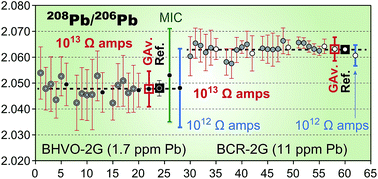High-precision in situ analysis of Pb isotopes in glasses using 1013 Ω resistor high gain amplifiers with ultraviolet femtosecond laser ablation multiple Faraday collector inductively coupled plasma mass spectrometry†
Abstract
We report high-precision in situ determination of Pb isotope ratios in glass samples, using 200 nm ultraviolet femtosecond laser ablation coupled with a multiple Faraday collector-inductively coupled plasma mass spectrometer (MFC-ICPMS), equipped with 1013 Ω resistor high gain Faraday amplifiers. The use of the highly sensitive ion interface of MFC-ICPMS together with the state-of-the-art amplifiers enabled determination of 208Pb/206Pb and 207Pb/206Pb isotope ratios at the highest precision ever achieved from a laser crater with 30 μm diameter and 30 μm depth dug on glass samples containing 1.7–39 ppm Pb. The signal responses of the 1013 Ω amplifiers were slower than those of the 1011 and 1012 Ω amplifiers. We confirmed a strong linear correlation between the rates of signal intensity change for D208Pbi/dt and the measured isotope ratios [20XPb/206Pb]/dt for the same time intervals. The D208Pbi/dt values deviated around zero, and the [20XPb/204Pb]/dt value at the zero intercept of the linear regression line represents the Pb isotope ratio of the sample. The slope of the linear regression line was either positive or negative because of different combinations of the amplifiers, indicating that the response of the amplifiers differed individually. The slope also changed with the signal intensity for 208Pbi or D208Pbi/dt, i.e., it was flatter at low levels and steeper at high levels. By using these relationships, corrections were made on the time resolved data measured from a single crater. Furthermore, using the proposed analytical method, 208Pb/206Pb and 207Pb/206Pb isotope ratios in BHVO-2G (1.7 ppm Pb) and BCR-2G (11 ppm Pb) basalt glass samples were analysed by using the National Institute of Standards and Technology (NIST) standard reference material (SRM) 612 (38.57 ppm Pb) synthetic glass as an external standard. The laboratory bias of the basalt glass samples was ±0.05–0.15‰ RD (per mille relative difference) and intermediate precisions were ±3–7‰ 2 SD (per mille 2 standard deviation) for BHVO-2G and ±0.6–3.7‰ 2 SD for BCR-2G. These intermediate precisions, along with repeatability, were approximately 2–3 times better than those obtained by using either multiple ion counter ICPMS or MFC-ICPMS with 1012 Ω resistor amplifiers.

- This article is part of the themed collection: JAAS Recent HOT articles

 Please wait while we load your content...
Please wait while we load your content...